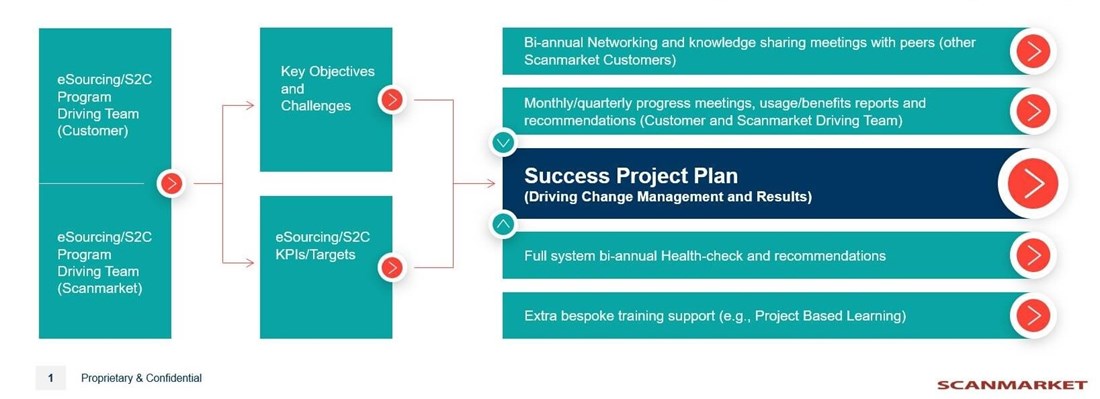To get the most from your source-to-contract (S2C) platform, you need an organized change management approach to ensure high user-adoption, fast time-to-market and excellent ROI.
Many software solutions on the market for sourcing and procurement teams make far-fetched claims, and it’s easy to get mesmerized by all the bells and whistles especially if your organization is looking to move from manual, legacy software to a cloud-based solution. Technology alone is not a silver bullet, and the key to success is having a true partnership with your solution provider. The single most important strength of a S2C provider should be their ability to maximize tangible business results that maximize ROI.
The Typical approach to S2C Success: Lopsided Partnerships
Defining S2C needs, selecting the right provider, implementing the tool, and training of staff is a time-consuming process. But planning for what happens next – i.e. change management and driving adoption is often overlooked. Providers, on their part, spend a lot of time on marketing and winning new customers but tend to reactively, rather than proactively, support customers in their efforts to succeed following implementation. Thereby, providing little in the way of structured support and guidance to ensure success of the S2C program, the result is a lopsided partnership.
A Better Way: True Provider Partnerships
Pre-implementation work is important. But the real work should begin post-implementation to ensure your team has the right resources, drive, knowledge and a plan for how to fully utilize the technology to meet their objectives and get up to full speed quickly.
A critical component in driving long-term success to maximize ROI from your S2C solution is a detailed plan and roadmap for beyond implementation. Planning and preparation of the change management process alongside driving adoption among users and stakeholders is key to quickly generating ROI. This is where the provider should be proactively and emphatically leading the way to success. After all, they have been involved in hundreds, if not thousands, of similar projects. Your team members are the procurement experts, and your solution provider should be the expert in driving S2C success.
The road to S2C program success is filled with challenges and barriers. One of the largest barriers to adoption can be resistance among team members who are opposed to change, comfortable with manual processes and legacy systems, or executive stakeholders who take an “if it ain’t broke, don’t fix it” mentality.
It is solely the provider’s responsibility, in partnership with procurement leaders, to help the teams and stakeholders understand the benefits of technology and digitization, and to weed out potential fears that automation and technology will replace their jobs. This will help to break down barriers and melt away resistance.
Breaking Barriers to Adoption with Project-Based Learning
Your team needs to feel confident and empowered by the new S2C solution, regardless of their level of tech-savviness. Users should be split into groups based upon technology competence levels and trained accordingly. This phased approach to S2C adoption with a Project-Based Learning Program will help your entire team get there quickly and comfortably.
In this approach, users are trained on upcoming real-life sourcing events, supplier management projects and contract creation/execution projects. This ‘learning-as-you-go’ approach means doing the work, rather than receiving days’ worth of theoretic and fictional training, also making it easier to recall what was learnt when it is actually needed.
Having a highly organized, pro-active approach to define KPIs and targets, create project plans to drive adoption across stakeholders, and a roadmap to achieve the KPIs/targets will ensure that the ultimate ROI is realized.

- The customer creates a multi-seniority level S2C driving team that includes key stakeholders from the contract signatory to a selection of super users, and key stakeholders in between. The customer team will work with the dedicated provider partner team to drive results. Crucially, the senior-most stakeholders will be responsible for one of the most important aspects of the whole project – top-down directive.
- Customer and provider partner to work together to define the customer’s phase 1, 2, and 3 objectives and challenges within the S2C remit.
- Customer and provider partner work together to define KPIs and targets that reflect the top objectives, based on wider procurement targets. This could also include simulations of a supply chain disruption or crisis, which may include: identifying and understanding disruption to the supply chain; mitigating the disruption so that your organization can deliver its prime business functions; quickly finding alternate suppliers to plug the supply chain gaps; protect your P&L against sharp price increases; massively speed up contract creation-to-signature cycle time.
- The provider partner creates a 12-month success project plan containing all suggested training and methodologies to be deployed, with monthly/quarterly milestones and integrated customer feedback.
- The success project plan is rolled out by the customer S2C driving team and provider partner.
- Provider partner fully supports and proactively drives the S2C program to ensure that monthly/quarterly KPIs/targets are hit.
- Monthly/quarterly performance update reports (including recommendations from provider partners) are shared with the driving team to enhance performance against KPIs and targets if/where performance is falling behind.
- Bi-annual full system health checks showing wide-ranging stats from every area of the system and provider partner recommendations for enhanced usage/performance at a highly detailed level.
- Annual onsite meeting with all key stakeholders to review the year and plan for the next year.
- 10. Repeat cycle from step 2-9.
Next Steps
Digitizing your S2C process does not have to be a complete overhaul and it can be done in steps to help support internal buy-in and speed up time to implementation, and importantly, ROI. Finding a technology provider partner who understands your business and wants to help you achieve your goals will not only provide a substantial return on your investment. It will also create long-term, sustainable value for the organization.
Are you looking for a provider you can partner with to grow your strategic sourcing program? Book a Free Consultation with one of our Strategic Sourcing Experts to get started, or learn more about our SuccessPlus Program and Project-Based Learning that helps our customers meet their objectives, provides ROI, and generates long-term value.













